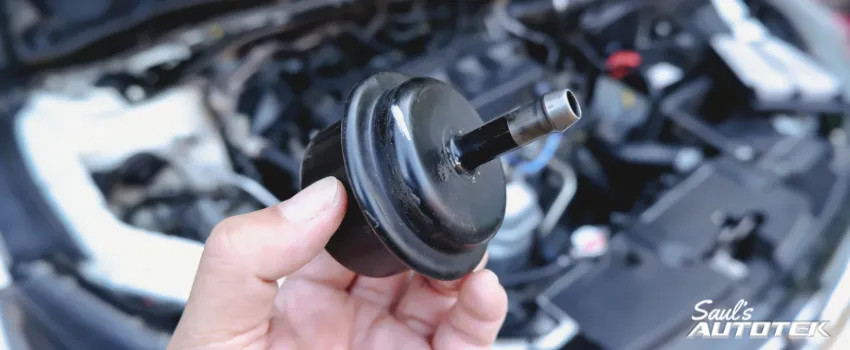Hi, folks. I’m Saul Reisman here at Saul’s Autotek, and today we’re going to talk a little bit about driving in the mountains, brakes, and these Toyotas that we keep seeing a lot of.
Now, we’re here in the Rocky Mountains, middle of Colorado, and we see lots of travelers, lots of tourists, going up and down I-70, using their brakes the whole time going down those mountains. Not a great idea, easy way to burn up the brakes. We’re here to show you a few ways that you can avoid that, and avoid having problems in the mountains with your vehicle. On any motor vehicle, when you’re driving down that mountain, you should be downshifting down those gears to slow your speed down. Use those gears to maintain speed, use the brakes to decrease speed, but never to maintain it. One of the things that we’re going to show you on this 2012 Toyota Forerunner that we’re working on today, is what happens if you use those brakes coming down the mountain, how some vehicles are designed, and what you can do to prevent future problems and keep your vehicle in the best shape possible.
Now, this vehicle was equipped from the factory with four-wheel disc brakes.
A good brake design has a lot of surface area so that airflow can get into those brakes to help keep them cool. Anything that translates to lighter weight in the vehicle is better fuel economy at the pump for you. Anything that translates to less rotating weight, like that brake rotor, is better steering, suspension, and handling characteristics of the vehicle. It feels more like a car than a truck. However, there are a few detriments to that. The first being, if you use those brakes coming down the mountains, you’re going to burn up the brake pads. You’re also going to risk potentially overheating that rotor.
Now, let’s look at the brake rotor on this Toyota 4Runner in Denver.
The rotor itself is like a record, big doughnut, and in the middle is where it attaches to the vehicle. The outer edges don’t have anything to attach to, they’re just freewheeling, floating around. As a result, this means that when that brake rotor gets hot, and from you applying the brake and generating friction against it, it gets very, very hot. We have to get that heat away from that brake rotor as quickly as possible. This vehicle was equipped with a vented rotor, two pieces of metal with channels in the middle, to get airflow through it as much as we can. However, they really weren’t designed for use and abuse in the high country of Colorado or any real serious mountain driving.
So what we’ve taken the liberty of doing this morning, is using our handy dandy paint pen, we have painted the brake rotors on all four corners of this vehicle. It has a six-spoke wheel, so we’ve grabbed those at six different locations, where we can just paint a straight line across the rotor. The reason we do this is this is a simple, quick, and cost-effective way to check the run out of the rotor. Is the rotor spinning perfectly true, or has it warped from having too much heat and cooling down too quickly? Oftentimes, if you get a brake rotor really, really, really hot, you will get the center of it to cool down much, much faster than the outer edges. As a result, the metallurgy of the rotor can actually change, it can warp and affect the way that it handles. In the future, you hit the brakes, you get a wobble, a vibration, a weird feeling in the steering wheel, it makes you uncomfortable, makes you less safe, and makes you a less predictable driver.
Let me show you what we did. Now, we’ve taken the liberty of drawing a white line with a paint marker in six different locations on this wheel. Now you can see that the inner portion of that paint is worn off, however, the outer is not. That tells us that one portion of the pad is getting forced against that rotor, and one isn’t. That would be indicative of that rotor being warped. I’m going to go ahead and spin this wheel just so we can see how the others are coming out. Similarly, here we can see that the inner has taken that paint off, but the outer still has the majority of the paint on the vehicle. As we rotate around, we’re going to see this similar type of pattern in all different places.
On this corner, we can actually see it took the majority of the paint off and left just a small line right towards the outer edge. And that’s the only spot it didn’t contact. So we’re getting good adhesion there and in a couple of other spots. However, we’re getting a pretty uneven pattern. We’re seeing paint on the inner and outer edge, but we’re still leaving it right there in the middle. You’ll notice that darker line in the middle of the rotor, that’s because, just like when you use something and you get it covered in oil, and that oil gets hot, you get that rainbow effect. This is a bare piece of steel, and now that it’s gotten really hot, we’re actually heat treating the metal by how hot those brake pads have gotten against it. That’s why those edges on the inner and outer look shiny, the one in the middle look’s kind of dark, it has become really hot.
Now, these are the back brakes. They normally take only about 20% to 30% of the force, and they’re warped. So let’s get a look at the fronts. On the front of the vehicle, we’ve done the same thing. We’ve simply painted a line straight across the rotor, so that we can see what kind of wear pattern we’re getting on it. You can see on this line, we’re only touching about the inner 10%, we’re not even contacting the outers. As we rotate around, you’ll start to see a similar pattern. We’re only contacting the inner edge, and we’re barely even contacting the outer, and we’re leaving the middle of that paint completely untouched. What that tells us is that these front rotors got way hot, and as a result, aren’t getting good surface contact. If we hop over to the other side, we’ll see the same pattern.
We can see that the inner edge of the paint is gone, but the majority of that outer is still completely intact. Again, we’re going to see this pattern start to become pretty prevalent as we go around. What this tells us is that this rotor got hot, however, it did not cool down properly. There are a couple of things that could be affected when this happens. First off, it absolutely warped the rotor, and then the only thing holding that brake caliper and pad straight is the actual slide pins on the caliper. Your caliper is designed to float, just like your hand has fingers and a thumb, and you grab from both sides.
Your brake caliper, in some cases, can only grab from one side. As a result, that would create uneven force. So the caliper, just as my knuckles are pivoting, must slide across. Your caliper uses two slide pins to allow that to happen. In the case of this vehicle, that means that with those brake rotors warped and you apply the brakes, those slide pins allow that caliper to move back and forth to keep it centered on the rotors. So it gets a good grip no matter what. However, that means thanks to those warped rotors, those calipers are sitting here chattering, shaking back and forth the entire time. That heats up the slide pins, gets the grease on those slide pins way hot, and will very, very quickly degrade that grease, which leads to a caliper that doesn’t slide, and leads to a caliper that locks up. Big problem, major expense, and could very much stop your vehicle on the road.
So definitely a reason that we want to get those warped rotors taken care of as soon as possible. Another effect of it is, the steering of the vehicle is designed in most pickups and SUVs, to be as small, lightweight as possible, so that it feels like a car rather than a truck. The detriment of that is, just like you feel those calipers sliding back and forth in the front end, shaking from those rotors being warped, the steering gear itself that pushes side to side, also known as the rack and pinion, will physically push and oscillate, matching those front tires, trying to match that force. As a result, where the rods themselves come out of the shoulder, as you would see on my arm, the actual seals begin to break down, lose their continuity, and eventually leak fluid.
Now, the rack and pinion, just like my body has blood inside, has fluid inside it that is never supposed to leave. Unfortunately, if you shake me hard enough, eventually something’s going to leak out and not work so right. The same thing happens to that rack and pinion. You shake it hard enough, here’s what happens. Our steering mechanism, that goes from one side of the vehicle, all the way across to the other side, disappears over us here, and pops back out on the other end, is protected by these rubber boots inside. These rubber boots are supposed to just be a dust protectant. There’s no fluid in here, this is just designed to keep dust off getting on the seals inside the rack and pinion. However, when it’s been used and abused and has a warped brake rotor, it shakes this rack and pinion side to side. As a result, we get this discoloration in the boot that we see here.
Now, you can see the bottom half of this boot is a darker color. This is because it’s wet in the bottom portion of it. Now, we’re not going to go ahead and poke it, but if we were to poke this with a needle, we’d actually have fluid drip out. As you can see, it’s darker right here is because this fluid is leaking out of the rack and pooling inside this boot. Now, I reiterate, there’s never a reason that there should be fluid in that boot. Inside there is just a seal that has fluid behind it. That boot should just be keeping dust out, not fluid in. So the fact that we can see that rubber deteriorating, we know that there’s fluid inside it, means we can prove that rack and pinion is leaking from that inner seal.
Not only did this vehicle come from the factory with a relatively small rotor that wasn’t designed for these mountain-use conditions, but this vehicle got used in those conditions anyway, warped those brake rotors. And as a result, needs rotors replaced, we’ll get brake pads with it, and unfortunately, has destroyed the rack and pinion in this vehicle. This is a very common failure with Toyota motor vehicles. If you have a Toyota motor vehicle, you drive in the Rocky Mountains, and you’ve got concerns about yours, or you simply want to make sure that you’re doing the best preventative maintenance to keep yours on the road, come and see us here at Saul’s Autotek.
We’re open 365 days a year, just like today on the Fourth of July weekend.
So that we can keep these folks on the road, out enjoying, and having a fun time in the mountains. If you want to get out and enjoy yours, and you don’t want to worry or think about your car, come and see us, seven days a week, 303-919-7769. We’ll be here to get you to stop.
Schedule Your FREE diagnostic Subaru Outback Auto Repair Upkeep and Repair Appointment
Check out Our Reviews On Yelp! And Leave A Great One For Us!
Join Our Conversation on Facebook
Explore Our Exceptional Denver Auto Repair Services
- Brake Repair Service
- Suspension Repair
- Steering Repair
- Engine Repair
- Automotive Air Conditioning and Heating Repair





